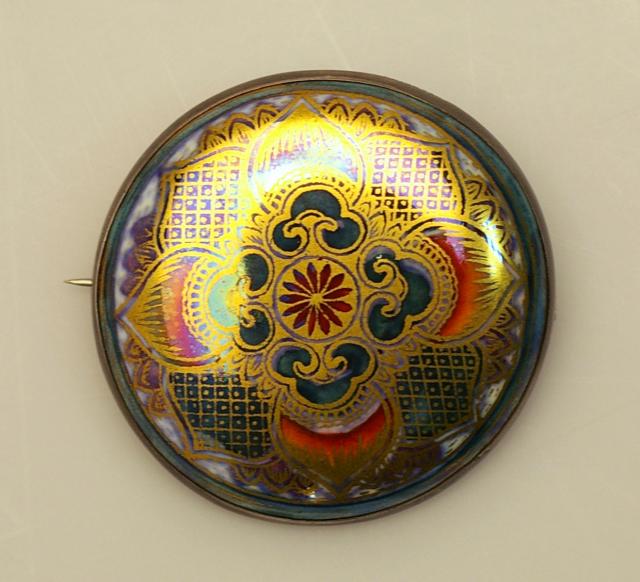Wedgwood and Jewellery: Lustre Brooch
This brooch was designed by Daisy Makeig-Jones for Wedgwood in 1920. It is made of bone china, hand-printed and hand-coloured, and reprinted in gold. The actual bone china plaque is mounted in a silver setting, hallmarked Sterling. It belongs to the first series of lustre decorated pieces called Ordinary Lustre, first launched in 1915, and is not to be mistaken for the famous Fairyland Lustre, as these two styles are very different in design. Ordinary Lustre used recognisable combinations of lustre colours, such as orange or blue and mother-of-pearl, and a range of motifs that had already been used for a number of years like fish, butterflies, insects, dragons, and Oriental motifs.
This special design, and her extraordinary use of lustre, developed mainly due to Makeig-Jones’ keen interest in the experiments into the secrets of Chinese decoration techniques that she conducted at Wedgwood. This also fostered her interest in Far Eastern motifs like the pattern to be seen on this brooch, which is called Chi Khiang design.
Susannah Margaretta ‘Daisy’ Makeig-Jones was born in 1881 in South Yorkshire as a doctor’s daughter and the oldest of seven children. She loved to read to her siblings and popular children’s books, such as the Colour Fairy Books by Andrew Lang, would become a major source of inspiration.
Fortunately, her family had the wealth to support her ambitions by sponsoring art classes as well as connections in society to help her progress. These connections laid the foundation for her work at Wedgwood and, in 1909, she applied to Cecil Wedgwood, Chairman of the Wedgwood company, who hired her as an apprentice. She rapidly advanced due to her art education and, two years later, she was engaged as a trainee paintress. By 1914, she became one of several Wedgwood designers and was given her own studio.
The Ordinary Lustres were an outstanding success, their bright colours acted as a foil against the misery of war, and it was suggested that more elaborate designs should be developed to meet the increasing demand. This was where the fairytales of Daisy Makeig-Jones’ childhood would surface. She combined fantastic landscapes with mythical creatures in the most flamboyant lustre colours and the Fairyland Lustres were born.
Daisy Makeig-Jones retired in 1931 just as the public was looking ahead to new modern styles.
